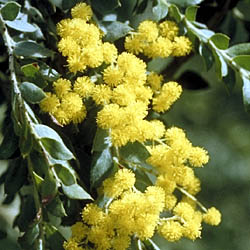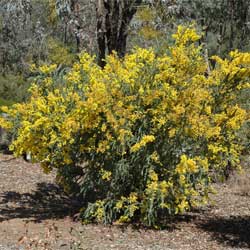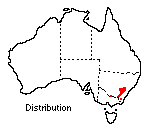Acacia vestita
 |
 |
Hairy Wattle
The Hairy Wattle (Acacia vestita), sometimes called Weeping Boree, occurs naturally in a few localities on the western slopes and southern tablelands of New South Wales. This Acacia is a graceful, free-flowering shrub with weeping branches and 'downy' foliage.
 Planted
in an open, well-drained position it forms a large, slightly spreading, bushy
shrub up to 3 m high with a spread of 3 m. It may also tolerate heavier clay
soils. Flowering begins in early August and continues until October. Bright
yellow flowers are borne in dense globular heads 3 mm in diameter. The flowers
are arranged in loose racemes 3 - 5 cm long.
Planted
in an open, well-drained position it forms a large, slightly spreading, bushy
shrub up to 3 m high with a spread of 3 m. It may also tolerate heavier clay
soils. Flowering begins in early August and continues until October. Bright
yellow flowers are borne in dense globular heads 3 mm in diameter. The flowers
are arranged in loose racemes 3 - 5 cm long.
The foliage consists of phyllodes - flattened or modified leaf stalks which serve the same functions as leaves. The phyllodes are obliquely ovate-elliptical in shape, 1 - 2 cm long and 5 - 1 0 mm wide with a fine point. These small, soft, greyish phyllodes and branchlets are covered with tiny hairs. The weeping branches give the plant an attractive appearance even when it is not in flower, although when in flower it is among the more attractive wattles.
Regular pruning is recommended to maintain a healthy bushy shrub and this should be done after flowering; old wood will not regenerate so this may be cut out completely provided that new shoots are present.
Propagation is by seed, which requires treatment before sowing to allow water to permeate through the hard seed coat. Treatments include pouring near-boiling water over the seeds, rubbing seeds between two sheets of sandpaper, or scratching them with a file.
In Canberra a light dressing of blood and bone fertiliser twice a year in February and August is sufficient to produce satisfactory growth.
There has been no record of any pests or diseases attacking this species and it seems to be fairly resistant to root-rot fungus.
Text by ANBG staff (1975)
Name meaning: Acacia vestitaAcacia - thought to be from a Greek word meaning 'sharp' or 'thorn' in reference to the first species discovered; or from the Egyptian Thorn (akakia), a species of Acacia which yields gum arabic; vestita - clothed, referring to the hairy covering of the phyllodes |
![An Australian Government Initiative [logo]](/images/austgovt_brown_90px.gif)

